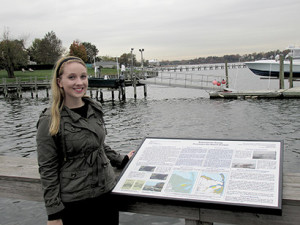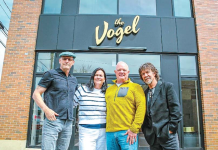Story and Photo by John Burton
FAIR HAVEN – After about a decade of work, Fair Haven has now added a piece of riverfront property to the list of borough preserved open space.
Local and county officials along with representatives from the Monmouth Conservation Foundation announced last Friday they have closed on the sale on 78 DeNormadie Ave., a .69-acre parcel overlooking the Navesink River that will eventually become a passive park for public recreation.
The borough has acquired the site for $1,159,500, with the selling price paid using both borough funds and a collection of grants, according to Mayor Benjamin Lucarelli.
According to the mayor, the borough received $608,750 from the state Department of Environmental Protection’s Blue Acres program, a program to purchase flood-prone property; $250,000 from the Monmouth County Open Space program; the Monmouth Country Conservation Foundation contributed $100,000; and borough taxpayers supplied $200,750, by way of a borough council authorized bond ordinance.
“Think about how wonderful it is all these organizations working together,” to acquire this space, said Monmouth County Freeholder Director Lillian Burry at a press conference conducted last Friday on the property to announce finalizing the sale.

This acquisition adds to the list of more than 6,500 acres that the Monmouth Conservation has helped preserve in its 37 years, observed William Kastning, the foundation’s executive director. But the site’s benefits are significant, despite its relatively small size, Kastning stressed. “Look at what you’re getting in terms of access to the waterfront and this view,” he said as he stretched his arm toward the Navesink, with boats still on the water.
Borough officials have been attempting to acquire the site for more than a decade, said Lucarelli. Part of the delay stemmed from an error in a 1910 deed when the site’s original two lots were improperly conveyed, which went undetected for nearly a century, the mayor said.
The property, commonly known as the Williams-Robards property, was first purchased in 1854 by Charles Williams, a former slave, and has remained in the same family since then, Lucarelli explained.
No formal plans have been drafted for the site yet, said borough administrator Theresa Casagrande. But the idea will be to eventually demolish the more 150-year-old home, once the borough Historical Commission reviews the site, she said.
Then, Lucarelli said, the thinking is to clean up the shoreline, and install plantings and some benches overlooking the river. The borough will also place a plaque on the site in recognition of the Williams-Robards family, he said.
Lucarelli added the council will apply for any available grants to assist in these efforts.














